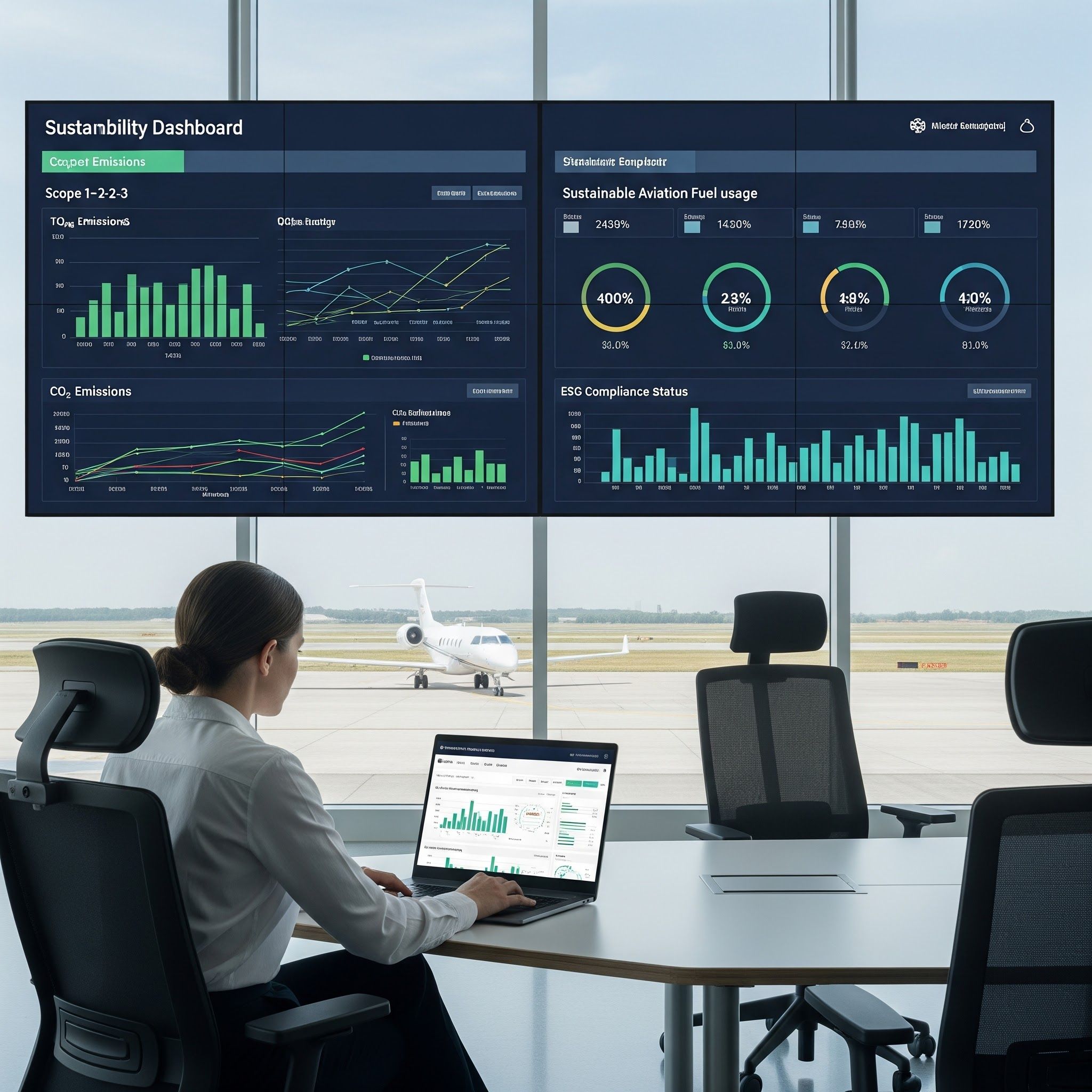
Greenhouse gas emissions reporting l CSRD, ESRS, and Private Aviation
Why the CSRD will transform reporting obligations for private jet operators
Published Tuesday, September 30, 2025
The Corporate Sustainability Reporting Directive (CSRD) is set to reshape sustainability reporting across the EU. It expands mandatory disclosures for in-scope undertakings (by size/listing). For private aviation, operators are directly in scope only if they meet CSRD thresholds; otherwise, the impact is indirect via CSRD-regulated corporate clientswho will demand higher-quality, verifiable data. Implementing CSRD-aligned processes will require stronger data collection, governance, and limited assurance—but it also creates an opportunity to strengthen ESG credibility, transparency, and stakeholder engagement.
Summary:
- Overview of the Corporate Sustainability Reporting Directive
- New reporting expectations for private jet operators
- Implementation timeline and compliance challenges
- Strategic implications for private jet operators
Overview of the Corporate Sustainability Reporting Directive
Scope and applicability to the aviation sector
CSRD does not target aviation as a sector; it applies to companies that meet scope criteria (e.g., large undertakings by size thresholds and listed SMEs). Many EU-based airlines and some larger business aviation companies will fall in scope; others will not.
For large undertakings, a company is in scope if it exceeds at least two of three: 250 employees, €50m net turnover, €25m total assets (on average over the year). Listed SMEs follow separate rules.
Overall, CSRD raises transparency expectations across aviation: in-scope entities face the reporting duty, while non-in-scope operators will feel indirect pressure as corporate clients request better data for Scope 3 (business travel) and RFPs.
Main sustainability disclosure requirements
Under CSRD, in-scope companies report using European Sustainability Reporting Standards (ESRS) and obtain limited assurance. For aviation:
- Climate (ESRS E1): disclose Scopes 1–2–3 where material (gross figures) and a GHG intensity metric (tCO₂e per net revenue). Any carbon credits or SAF (book-and-claim) are disclosed separately and do not reducegross Scope 1–3. Note: Per-flight or per-passenger metrics are not mandated by ESRS; they’re business-driven and often requested by clients.
- Energy & fuels: disclose energy use and progress (e.g., SAF uptake) where material.
- Resources, pollution, waste: report if material (e.g., ESRS E2/E5 topics).
- Social topics: workforce, D&I, H&S—if material.
- Governance: roles/oversight, risk management, business conduct; describe if variable pay is linked to sustainability (no obligation to link it).
New reporting expectations for private jet operators
Emissions and environmental impact
For in-scope operators: report under ESRS E1 (Scopes 1–2–3, where material) and GHG intensity, with clear methods and factors.
For operators not in scope: expect client-driven requests for flight-level evidence to support clients’ Scope 3 (business travel). Per-flight/per-client certificates are commercially valuable, but not a CSRD legal requirement for operators.
Note: Flight-level evidence supports corporate clients’ Scope 3.6 (business travel) under the GHG Protocol, but it does not alter the operator’s gross Scope 1.
Social and governance
Disclose material workforce/governance metrics (e.g., headcount, H&S indicators, governance roles/controls, business conduct). If ESG KPIs affect variable pay, describe them; no rule says they must.
Supply chain due diligence
Under CSRD, companies report policies/processes where material. The substantive due-diligence obligations arise mainly from the CSDDD (separate instrument, phased later). Operators should implement supplier screening, codes of conduct, and audits proportionate to material risks—and be ready to explain the framework in CSRD reports if material.
Implementation timeline and compliance challenges
Reporting phase-ins (high level)
Update (2025): Beyond legacy NFRD reporters (still reporting in 2025 on FY2024), the EU has proposed deferring most first-time CSRD reports by two years—i.e., reports in 2028 for FY2027—subject to adoption and national transposition.
- Ex-NFRD entities: first CSRD reports in 2025 (covering FY2024).
- Other large companies: first CSRD reports in 2028 (covering FY2027).
- Listed SMEs (except micro): first CSRD reports in 2029 (covering FY2028).
There is no CSRD calendar by aircraft weight/MTOM—that belongs to ETS/MRV/CORSIA, not CSRD.
Data collection and reporting processes
- Start with existing operational data (fuel uplift, flight logs), supplier documentation (fuel delivery notes, SAFchain-of-custody), and—where available—EU-ETS/MRV datasets. No new onboard equipment is required by CSRD.
- Use ESRS/GHG Protocol-consistent methods; disclose factors, assumptions, and estimates to close data gaps.
- Build data governance and internal controls (sources, timestamps, versioning, approvals) to support limited assurance.
- Provide ESRS-aligned exports to corporate clients (per-flight proofs and client consolidations) to win RFPs and simplify their Scope 3 reporting.
- Systems can start with controlled spreadsheets and scale to platforms—the priority is traceability and a solid audit trail.
Strategic implications for private jet operators
Reputation and transparency
For in-scope operators, CSRD raises the bar on verifiable disclosure. For others, client expectations do. Transparency may invite scrutiny, but it also differentiates operators who can prove reductions (efficiency, load factor, routing) and document SAF use.
Competitive dynamics
Increased disclosure will intensify competition on sustainability performance. While assurance-ready data may favor larger players, smaller operators can compete with verifiable flight-level evidence and clean data pipelines that integrate into clients’ CSRD workflows.
Driving improvements
CSRD is a catalyst for better data and governance. It does not require buying “clean tech” or offsetting—but leaders will pair measure-and-reduce with high-quality offsets for residuals (voluntary), communicate precisely, and back claims with proof.
Bottom line: Turn compliance pressure into advantage with ESRS-aligned evidence per flight, robust controls, and credible progress narratives.
Book a private flight
With Orizair, discover hundreds of available flights to reach your destination the green way.
Find your destinationAt Orizair, we integrate sustainability into private aviation by automatically offsetting the carbon emissions of every flight and collaborating with committed partners like Treesition. Discover our commitment.